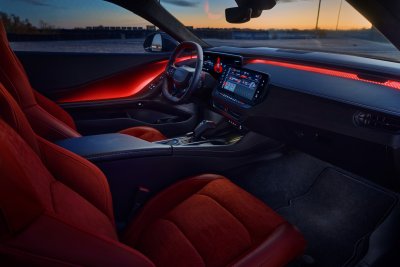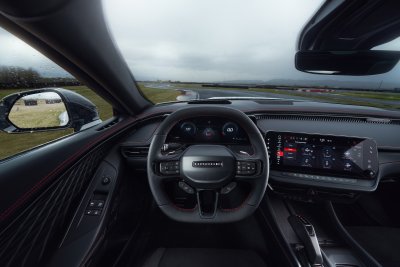Transitioning iconic vehicles into the electric era has so far been difficult. Ford took heat for years for using the legendary sports car’s name in the Mustang Mach-E moniker. Chevrolet hasn’t even tried with the Camaro, killing the model instead.
Dodge, a muscle car company that built much of its modern reputation on putting V8 engines in everything in its lineup, is launching a new all-electric sports car, the two- or four-door Charger Daytona.
The company will first offer the most powerful, quickest vairnat for sale, the two-motor, all-wheel drive, 670-horsepower (hp) 2024 Dodge Charger Daytona Scat Pack. It will be joined on sale by the near-500-hp electric Charger Daytona R/T next year.
Taking one of the brand’s icons and going electric is sure to put off some of the few remaining traditional muscle car buyers, but Dodge and its CEO Matt McAlear understand that if they can do it the Dodge way, it can work.
To test to see if it works, I headed out to Arizona’s Radford Racing School as one of the first journalists invited by Dodge to try out the car.

Stellantis

Stellantis
“At Dodge, we revel in being different and pushing the line,” McAlear said. “We don’t tiptoe the line. We blow right through it. We know who we are, we know what we stand for. And most people think we’re a little off, a little crazy, that’s fine. We’re more than happy if 95 percent of the population buying public thinks we’re just out there, because if we stood for everyone, we would stand for nothing.”
Dodge hasn’t lost a step in its powertrain evolution. The trick with electric vehicles is to hide that extra battery weight, and most of the time (Auto, Sport, Track and Drag driving modes) the Charger Daytona does it well. Utilizing Donut drive mode on a small drift course made to test the Charger Daytona Scat Pack’s sliding ability is the only time the 5,700-pounder actually felt heavy.
McAleer said the new Charger needed four things to be a true Dodge: It needs to look, feel, drive and sound like a Dodge. The looks are taken care of by exterior designer Scott Krugger and team, and it certainly hits the bullseye.
Staring at the sheetmetal, the two-door electric muscle car looks like the Charger and Challenger had a baby. Four-door versions and internal combustion engine versions will follow next year, all on the same new STLA Large platform. All feature the new R-duct, similar to new sports cars from Ferrari and Chevrolet, that allows for a low opening on the grille that adds downforce on the nose and reduces some of the wind drag on the front end of the vehicle.

Stellantis

Stellantis
The side profile looks more like a Challenger, though this vehicle is bigger and has more space for passengers than that outgoing model. But, it has the same low-to-the-ground and looking-fast-while-standing-still attitude. The rear features a brighter, complete taillight, shaped like a ring, like the last-generation Charger sedan.
Dropping inside the low cabin, the new EV muscle car also feels like a Dodge with red and black accents, ambient mood lighting that changes with the drive modes, and a new pistol-grip shifter with ignition button right behind it. The rear seats are bigger by a long shot than the outgoing Challenger, which was already one of the most comfortable rear areas in a two-door vehicle.
The cockpit is canted towards the driver and the warm glow of the ambient lights bathe the cabin in red. There are several options for seats including new high-backed, hard-shelled units, though we only tested the middle-priced versions that are powered and heated, wide and comfortable for all body types (though they didn’t hold me in place in fast corners as much as I would have liked).
The graphics on the 16-inch digital instrument cluster will look familiar to Dodge drivers. The 12.3-inch infotainment touchscreen has Performance Pages with gauges and timers like the Challenger, along with a screen for customizing the drive modes. It feels familiar and natural, and everything necessary is within a few button pushes of the top menu. The red and black Dodge accents and extend into the screen graphics.
The perforated, squared off steering wheel was comfortable when driving hard around the Arizona desert roads, featuring buttons controlling drive modes, adaptive cruise control, menus and the Power Shot, whichunlocks the maximum horsepower for 10 seconds.
Maximum horsepower is what makes this Dodge drive like a true Dodge. No, it’s not the 707- or 808-horsepower Hellcat, but because of all-wheel drive and two 335-hp electric motors the new Charger Daytona Scat Pack is quicker to 60 miles per hour. It takes just 3.3 seconds with launch control engaged, enough to send a heart palpitating and guts into a bunch in the back of your ribcage.
It’s not just fast from a standstill. If you matted the throttle on the expressway while already going 70 mph, you could hit triple digits in seconds.

Stellantis

Stellantis
The car’s six-piston front and four-piston rear brakes slow the car with aplomb.
The drive modes adjust the throttle position, steering effort, adaptive suspension (four settings) and the amount of power available. Auto and Sport mode unlock 630 horsepower (with the Power Shot adding the other 40 hp) while Track mode only gives 535 hp at maximum. Only Drag mode allows for the full 670 ponies without using the Power Shot feature.
On the road course at the dry and dusty Radford Racing School, the Dodge showed that it can outdo its predecessors in speed and braking. However, with equally powered axles and all-wheel drive the front wheels start sliding long before the rears, and no amount of extra throttle would bring the rear wheels around. That’s a problem that the Hellcats did not have. On the other hand, the Daytona positively launches out of a corner once the wheels are pointed in the right direction.
The Fratzonic faux exhaust technology will get the town talking. The system features dual, extreme bandwidth speakers coupled with dual Fratzonic Chamber-loaded passive radiators, housed in a custom enclosure and powered by a dedicated amplifier. It works in concert with input from driver and vehicle meaning it gets ear-splittingly loud when going fast and makes a wild rev sound when the pedal is pressed in park or neutral. The tones change with the drive modes with Drag being the loudest.
At a stoplight, in one of those loud modes, is where I paused to pontificate on the nature of muscle cars and what really matters. Is it really fast? Yes. Does it look angry? Yes. Is it loud enough to annoy the neighbors? No question. Does it sound like a Dodge? Absolutely.

Stellantis

Stellantis
The new Dodge is the only electric muscle car on the market today. It comes in at $59,595 for the 2024 Dodge Charger Daytona R/T and $73,190 for the Daytona Scat Pack. It currently qualifies for the $7,500 IRA tax credit, but only on lease.
Dodge is still selling gasoline Chargers and Challengers, and has a new gasoline Charger on the way, meaning the Daytona’s competition will most likely come from inside the house (and maybe a little from Ford’s Mustang).
The trick will be convincing the traditional muscle car buyer. The fact that it looks, feels, drives and sounds like a Dodge means a test drive will go a long way to moving the skeptics.


